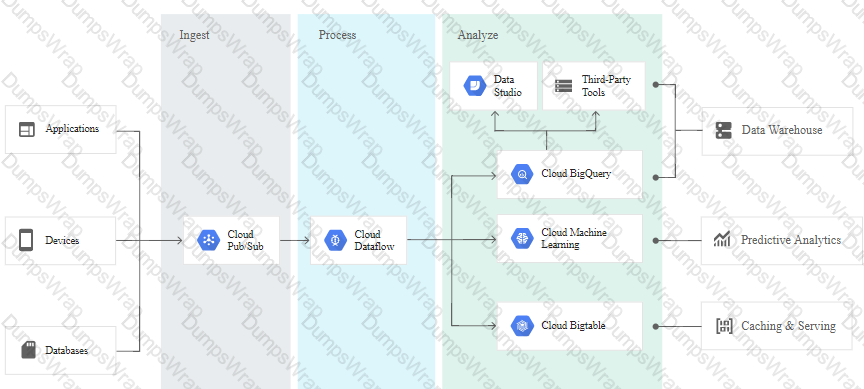Google Certified Professional - Cloud Architect (GCP) Questions and Answers
For this question, refer to the JencoMart case study.
The JencoMart security team requires that all Google Cloud Platform infrastructure is deployed using a least privilege model with separation of duties for administration between production and development resources. What Google domain and project structure should you recommend?
For this question, refer to the JencoMart case study.
JencoMart has built a version of their application on Google Cloud Platform that serves traffic to Asia. You want to measure success against their business and technical goals. Which metrics should you track?
For this question, refer to the JencoMart case study.
JencoMart has decided to migrate user profile storage to Google Cloud Datastore and the application servers to Google Compute Engine (GCE). During the migration, the existing infrastructure will need access to Datastore to upload the data. What service account key-management strategy should you recommend?
For this question, refer to the JencoMart case study.
JencoMart wants to move their User Profiles database to Google Cloud Platform. Which Google Database should they use?
For this question, refer to the JencoMart case study.
The migration of JencoMart’s application to Google Cloud Platform (GCP) is progressing too slowly. The infrastructure is shown in the diagram. You want to maximize throughput. What are three potential bottlenecks? (Choose 3 answers.)
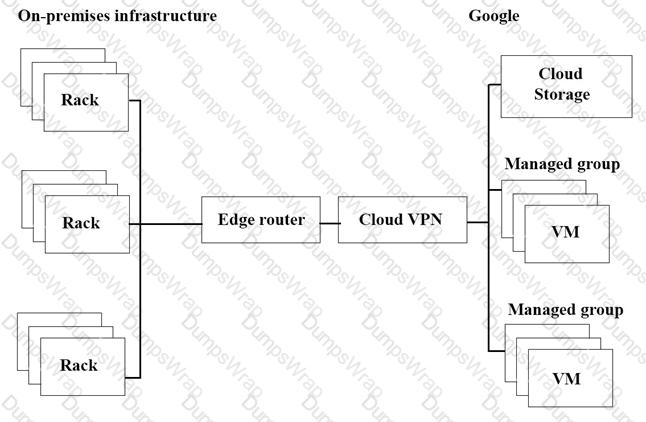
For this question, refer to the JencoMart case study
A few days after JencoMart migrates the user credentials database to Google Cloud Platform and shuts down the old server, the new database server stops responding to SSH connections. It is still serving database requests to the application servers correctly. What three steps should you take to diagnose the problem? Choose 3 answers
The current Dress4win system architecture has high latency to some customers because it is located in one
data center.
As of a future evaluation and optimizing for performance in the cloud, Dresss4win wants to distribute it's system
architecture to multiple locations when Google cloud platform.
Which approach should they use?
For this question, refer to the Dress4Win case study.
Dress4Win has asked you to recommend machine types they should deploy their application servers to. How should you proceed?
For this question, refer to the Dress4Win case study.
Dress4Win has end-to-end tests covering 100% of their endpoints. They want to ensure that the move to the cloud does not introduce any new bugs. Which additional testing methods should the developers employ to prevent an outage?
For this question, refer to the TerramEarth case study.
TerramEarth's CTO wants to use the raw data from connected vehicles to help identify approximately when a vehicle in the development team to focus their failure. You want to allow analysts to centrally query the vehicle data. Which architecture should you recommend?
A)
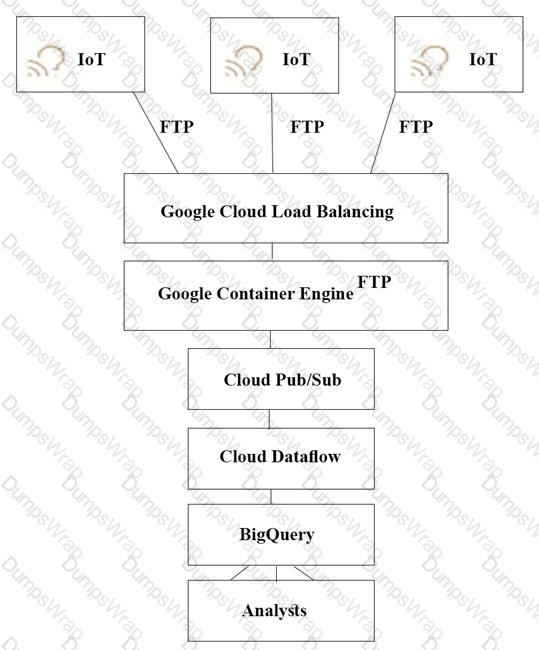
B)
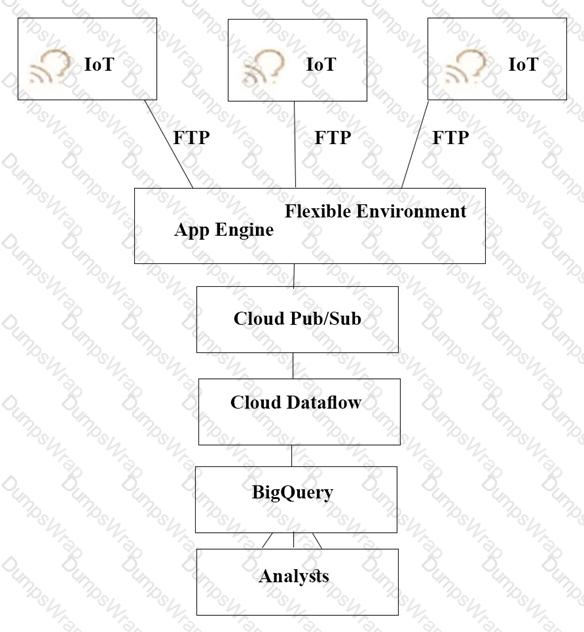
C)
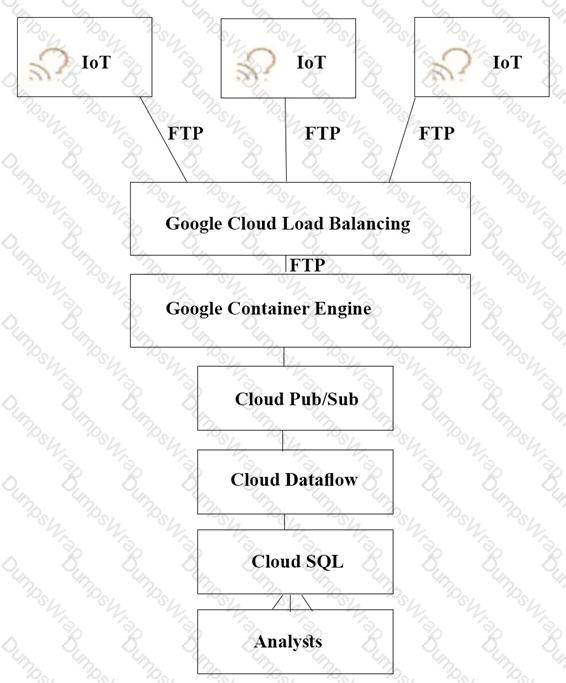
D)
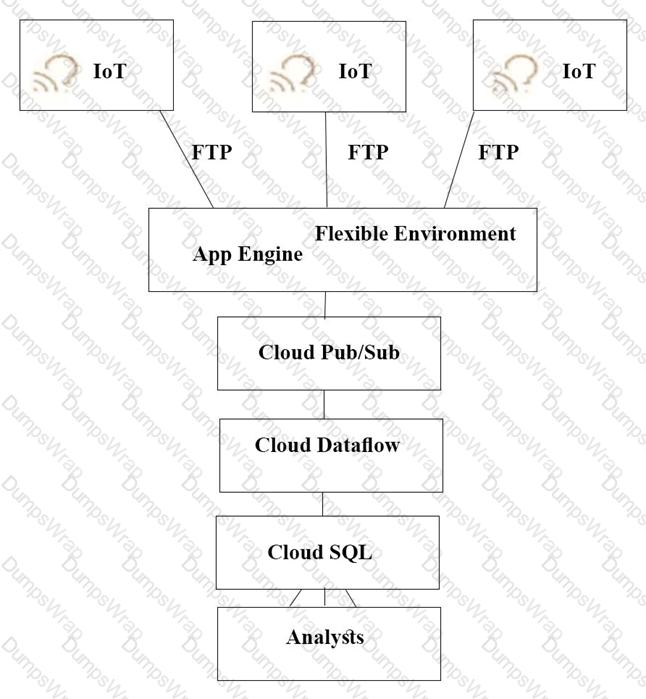
For this question, refer to the TerramEarth case study.
TerramEarth's 20 million vehicles are scattered around the world. Based on the vehicle's location its telemetry data is stored in a Google Cloud Storage (GCS) regional bucket (US. Europe, or Asia). The CTO has asked you to run a report on the raw telemetry data to determine why vehicles are breaking down after 100 K miles. You want to run this job on all the data. What is the most cost-effective way to run this job?
For this question, refer to the TerramEarth case study
You analyzed TerramEarth's business requirement to reduce downtime, and found that they can achieve a majority of time saving by reducing customers' wait time for parts You decided to focus on reduction of the 3 weeks aggregate reporting time Which modifications to the company's processes should you recommend?
For this question, refer to the TerramEarth case study.
To speed up data retrieval, more vehicles will be upgraded to cellular connections and be able to transmit data to the ETL process. The current FTP process is error-prone and restarts the data transfer from the start of the file when connections fail, which happens often. You want to improve the reliability of the solution and minimize data transfer time on the cellular connections. What should you do?
For this question, refer to the TerramEarth case study.
TerramEarth has equipped unconnected trucks with servers and sensors to collet telemetry data. Next year they want to use the data to train machine learning models. They want to store this data in the cloud while reducing costs. What should they do?
For this question, refer to the TerramEarth case study.
TerramEarth plans to connect all 20 million vehicles in the field to the cloud. This increases the volume to 20 million 600 byte records a second for 40 TB an hour. How should you design the data ingestion?
For this question, refer to the TerramEarth case study.
The TerramEarth development team wants to create an API to meet the company's business requirements. You want the development team to focus their development effort on business value versus creating a custom framework. Which method should they use?
For this question, refer to the TerramEarth case study
Your development team has created a structured API to retrieve vehicle data. They want to allow third parties to develop tools for dealerships that use this vehicle event data. You want to support delegated authorization against this data. What should you do?
For this question refer to the TerramEarth case study.
Which of TerramEarth's legacy enterprise processes will experience significant change as a result of increased Google Cloud Platform adoption.
For this question, refer to the EHR Healthcare case study. You need to define the technical architecture for hybrid connectivity between EHR's on-premises systems and Google Cloud. You want to follow Google's recommended practices for production-level applications. Considering the EHR Healthcare business and technical requirements, what should you do?
For this question, refer to the EHR Healthcare case study. In the past, configuration errors put public IP addresses on backend servers that should not have been accessible from the Internet. You need to ensure that no one can put external IP addresses on backend Compute Engine instances and that external IP addresses can only be configured on frontend Compute Engine instances. What should you do?
For this question, refer to the EHR Healthcare case study. You are responsible for ensuring that EHR's use of Google Cloud will pass an upcoming privacy compliance audit. What should you do? (Choose two.)
For this question, refer to the EHR Healthcare case study. You are a developer on the EHR customer portal team. Your team recently migrated the customer portal application to Google Cloud. The load has increased on the application servers, and now the application is logging many timeout errors. You recently incorporated Pub/Sub into the application architecture, and the application is not logging any Pub/Sub publishing errors. You want to improve publishing latency. What should you do?
For this question, refer to the EHR Healthcare case study. You need to define the technical architecture for securely deploying workloads to Google Cloud. You also need to ensure that only verified containers are deployed using Google Cloud services. What should you do? (Choose two.)
You need to upgrade the EHR connection to comply with their requirements. The new connection design must support business-critical needs and meet the same network and security policy requirements. What should you do?
For this question, refer to the EHR Healthcare case study. EHR has single Dedicated Interconnect
connection between their primary data center and Googles network. This connection satisfies
EHR’s network and security policies:
• On-premises servers without public IP addresses need to connect to cloud resources
without public IP addresses
• Traffic flows from production network mgmt. servers to Compute Engine virtual
machines should never traverse the public internet.
You need to upgrade the EHR connection to comply with their requirements. The new
connection design must support business critical needs and meet the same network and
security policy requirements. What should you do?
For this question, refer to the EHR Healthcare case study. You are responsible for designing the Google Cloud network architecture for Google Kubernetes Engine. You want to follow Google best practices. Considering the EHR Healthcare business and technical requirements, what should you do to reduce the attack surface?
For this question, refer to the TerramEarth case study. To be compliant with European GDPR regulation, TerramEarth is required to delete data generated from its European customers after a period of 36 months when it contains personal data. In the new architecture, this data will be stored in both Cloud Storage and BigQuery. What should you do?
For this question, refer to the Dress4Win case study. Which of the compute services should be migrated as –is and would still be an optimized architecture for performance in the cloud?
For this question, refer to the Dress4Win case study. Considering the given business requirements, how would you automate the deployment of web and transactional data layers?
For this question, refer to the Dress4Win case study. You are responsible for the security of data stored in
Cloud Storage for your company, Dress4Win. You have already created a set of Google Groups and assigned the appropriate users to those groups. You should use Google best practices and implement the simplest design to meet the requirements.
Considering Dress4Win’s business and technical requirements, what should you do?
For this question, refer to the Dress4Win case study. Dress4Win is expected to grow to 10 times its size in 1 year with a corresponding growth in data and traffic that mirrors the existing patterns of usage. The CIO has set the target of migrating production infrastructure to the cloud within the next 6 months. How will you configure the solution to scale for this growth without making major application changes and still maximize the ROI?
For this question, refer to the Dress4Win case study. You want to ensure that your on-premises architecture meets business requirements before you migrate your solution.
What change in the on-premises architecture should you make?
For this question, refer to the Dress4Win case study. To be legally compliant during an audit, Dress4Win must be able to give insights in all administrative actions that modify the configuration or metadata of resources on Google Cloud.
What should you do?
For this question, refer to the Mountkirk Games case study.
Mountkirk Games' gaming servers are not automatically scaling properly. Last month, they rolled out a new feature, which suddenly became very popular. A record number of users are trying to use the service, but many of them are getting 503 errors and very slow response times. What should they investigate first?
For this question, refer to the Mountkirk Games case study.
Mountkirk Games has deployed their new backend on Google Cloud Platform (GCP). You want to create a thorough testing process for new versions of the backend before they are released to the public. You want the testing environment to scale in an economical way. How should you design the process?
For this question, refer to the Mountkirk Games case study
Mountkirk Games needs to create a repeatable and configurable mechanism for deploying isolated application environments. Developers and testers can access each other's environments and resources, but they cannot access staging or production resources. The staging environment needs access to some services from production.
What should you do to isolate development environments from staging and production?
For this question, refer to the Helicopter Racing League (HRL) case study. HRL is looking for a cost-effective
approach for storing their race data such as telemetry. They want to keep all historical records, train models
using only the previous season's data, and plan for data growth in terms of volume and information collected.
You need to propose a data solution. Considering HRL business requirements and the goals expressed by
CEO S. Hawke, what should you do?
For this question, refer to the Helicopter Racing League (HRL) case study. HRL wants better prediction
accuracy from their ML prediction models. They want you to use Google’s AI Platform so HRL can understand
and interpret the predictions. What should you do?
For this question, refer to the Helicopter Racing League (HRL) case study. A recent finance audit of cloud
infrastructure noted an exceptionally high number of Compute Engine instances are allocated to do video
encoding and transcoding. You suspect that these Virtual Machines are zombie machines that were not deleted
after their workloads completed. You need to quickly get a list of which VM instances are idle. What should you
do?
For this question, refer to the Helicopter Racing League (HRL) case study. Recently HRL started a new regional
racing league in Cape Town, South Africa. In an effort to give customers in Cape Town a better user
experience, HRL has partnered with the Content Delivery Network provider, Fastly. HRL needs to allow traffic
coming from all of the Fastly IP address ranges into their Virtual Private Cloud network (VPC network). You are
a member of the HRL security team and you need to configure the update that will allow only the Fastly IP
address ranges through the External HTTP(S) load balancer. Which command should you use?
For this question, refer to the Helicopter Racing League (HRL) case study. Your team is in charge of creating a
payment card data vault for card numbers used to bill tens of thousands of viewers, merchandise consumers,
and season ticket holders. You need to implement a custom card tokenization service that meets the following
requirements:
• It must provide low latency at minimal cost.
• It must be able to identify duplicate credit cards and must not store plaintext card numbers.
• It should support annual key rotation.
Which storage approach should you adopt for your tokenization service?
For this question, refer to the Helicopter Racing League (HRL) case study. The HRL development team
releases a new version of their predictive capability application every Tuesday evening at 3 a.m. UTC to a
repository. The security team at HRL has developed an in-house penetration test Cloud Function called Airwolf.
The security team wants to run Airwolf against the predictive capability application as soon as it is released
every Tuesday. You need to set up Airwolf to run at the recurring weekly cadence. What should you do?
For this question, refer to the Mountkirk Games case study. Mountkirk Games wants to design their solution for the future in order to take advantage of cloud and technology improvements as they become available. Which two steps should they take? (Choose two.)
For this question, refer to the Mountkirk Games case study. You need to analyze and define the technical architecture for the compute workloads for your company, Mountkirk Games. Considering the Mountkirk Games business and technical requirements, what should you do?
Your development teams release new versions of games running on Google Kubernetes Engine (GKE) daily.
You want to create service level indicators (SLIs) to evaluate the quality of the new versions from the user’s
perspective. What should you do?
You deploy your custom Java application to Google App Engine. It fails to deploy and gives you the following stack trace.
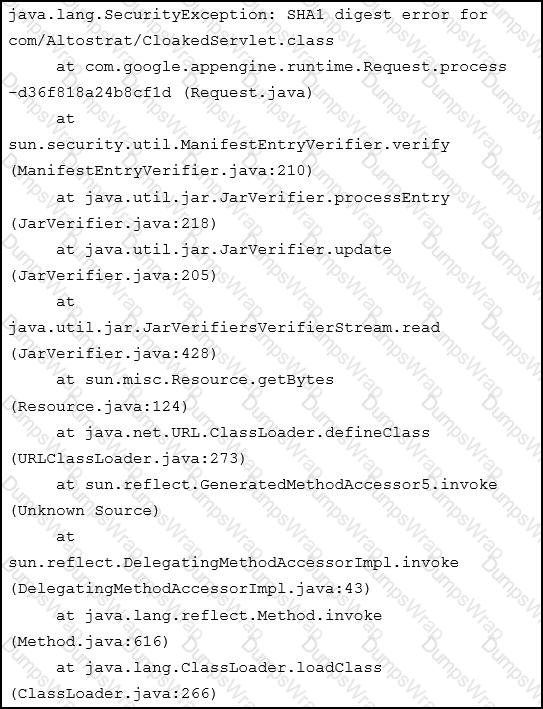
What should you do?
A development team at your company has created a dockerized HTTPS web application. You need to deploy the application on Google Kubernetes Engine (GKE) and make sure that the application scales automatically.
How should you deploy to GKE?
The application reliability team at your company has added a debug feature to their backend service to send all server events to Google Cloud Storage for eventual analysis. The event records are at least 50 KB and at most 15 MB and are expected to peak at 3,000 events per second. You want to minimize data loss.
Which process should you implement?
Your company wants to migrate their 10-TB on-premises database export into Cloud Storage You want to minimize the time it takes to complete this activity, the overall cost and database load The bandwidth between the on-premises environment and Google Cloud is 1 Gbps You want to follow Google-recommended practices What should you do?
You are using Cloud SQL as the database backend for a large CRM deployment. You want to scale as usage increases and ensure that you don’t run out of storage, maintain 75% CPU usage cores, and keep replication lag below 60 seconds. What are the correct steps to meet your requirements?
You are deploying an application to Google Cloud. The application is part of a system. The application in Google Cloud must communicate over a private network with applications in a non-Google Cloud environment. The expected average throughput is 200 kbps. The business requires:
• 99.99% system availability
• cost optimization
You need to design the connectivity between the locations to meet the business requirements. What should you provision?
The operations team in your company wants to save Cloud VPN log events (or one year You need to configure the cloud infrastructure to save the logs What should you do?
You need to design a solution for global load balancing based on the URL path being requested. You need to ensure operations reliability and end-to-end in-transit encryption based on Google best practices.
What should you do?
You want to enable your running Google Container Engine cluster to scale as demand for your application
changes.
What should you do?

